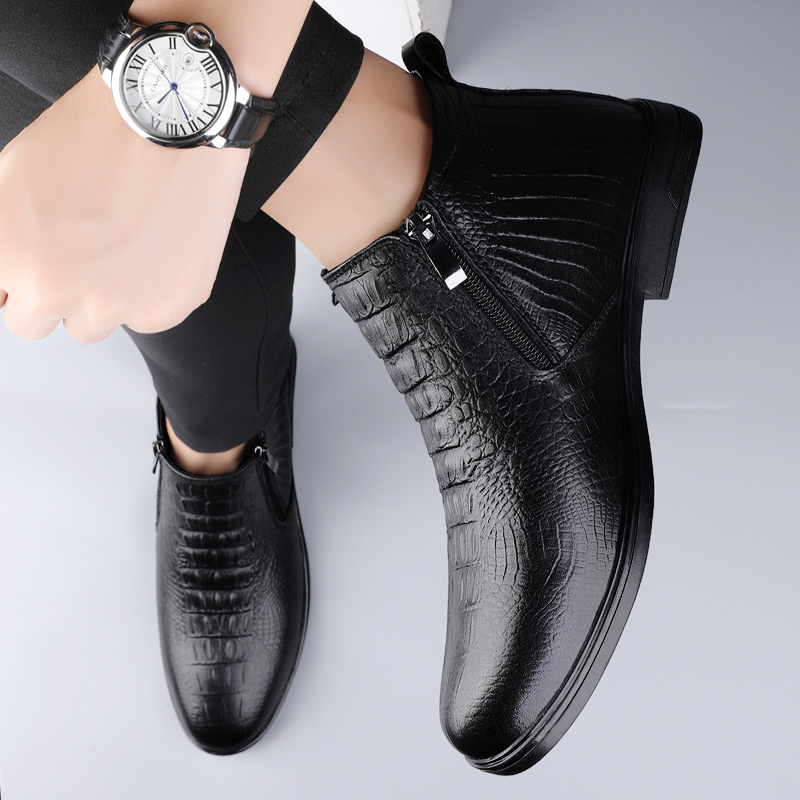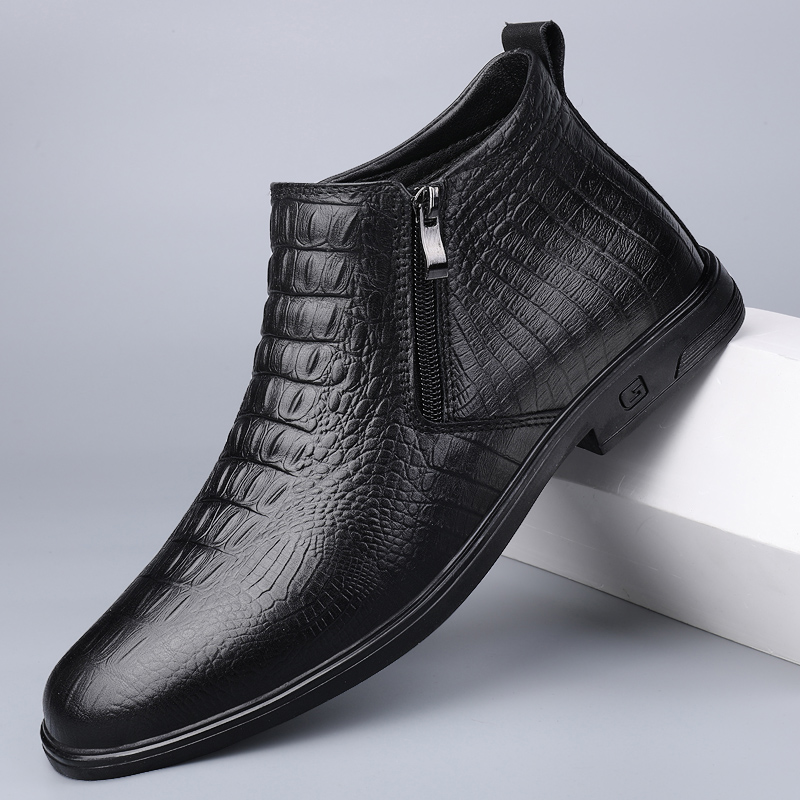Introduction: The Importance of Reliable Footwear
Choosing the right footwear is crucial for any outdoor enthusiast. Leather boots offer durability, comfort, and protection. They can handle rough terrains and keep your feet in good shape. Finding the best leather boots for your adventures means comfort and safety for miles. Quality, durability, fit, and proper care are the cornerstones of a good leather boot. This guide will take you through everything you need to know to make the best choice.

Assessing Leather Quality: Genuine vs High-Quality Leather
When choosing leather boots, the quality of the leather is critical. Genuine leather might be deceiving—this term doesn’t always mean top quality. It often involves minimal leather mixed with fillers. High-quality leather, like full-grain or top-grain, is much better. These materials come from the top layer of the hide and are more durable and moisture-resistant.
Identifying High-Quality Leather
To identify superior leather, check the raw cut edge and the backside. Look for dense, solid texture without any separation of layers. High-quality leather does not have loose fibers or a fuzzy appearance. It often smells more natural, without hints of chemicals. If exposed to a burn test, real leather chars, revealing a grain pattern that confirms its authenticity.
Recognizing Genuine Leather
Genuine leather often feels foamier and might show a blue tint from cheap tanning processes. Its fibers appear more disorganized and fuzzy on closer inspection. Although marketed as ‘real leather,’ it often lacks the durability and comfort of higher-end options. Therefore, when looking for durability and longer-lasting wear, aiming for full-grain leather is advisable. It offers better performance for outdoor activities and withstands harsh conditions more robustly.
Pros and Cons of Leather Hiking Boots
Leather hiking boots are a staple for outdoor lovers. Known for their robust nature, they offer great durability and can withstand various weather conditions, making them ideal for rough terrains. Here, we explore the advantages and drawbacks of opting for leather hiking boots for your adventures.

Pros
- Durability: Leather is tough and resists wear, prolonging boot life.
- Water-Resistance: Quality leather repels water to keep feet dry.
- Support: Sturdy leather offers excellent foot and ankle support.
- Protection: Thick leather protects against sharp objects and rough terrain.
- Resoling Option: High-quality leather boots can often be resoled, extending their usability.
- Aesthetic Appeal: Leather boots have a classic, timeless appearance that many find appealing.
Cons
- Weight: Leather boots are usually heavier than synthetic options.
- Price: High-quality leather boots can be expensive.
- Break-In Period: Thick leather may require a lengthy break-in period.
- Less Breathable: Solid leather offers less air circulation than mesh materials.
- Animal Cruelty Considerations: Some may object to the use of animal products for ethical reasons.
- Maintenance: Leather needs regular care to maintain its condition and appearance.
Choosing leather boots means finding a balance between their undeniable longevity and the considerations for comfort, ethics, and ongoing care.
Top Considerations When Selecting Leather Boots
Selecting the right pair of leather boots is not just about style, it’s about meeting your outdoor needs effectively. Let’s highlight key factors to consider when making your pick.
Fit and Comfort
Prioritize a snug fit without tightness. Ensure ample room in the toe area for movement. Comfort is king on long treks.
Durability
Look for boots crafted from high-quality leather. Full-grain or top-grain leather stands up to tough conditions best.

Traction
Good boots offer a strong grip. They should hold well on various terrains, wet or dry.
Weight
Lighter boots reduce fatigue. However, don’t compromise on protection or durability for less weight.
Ankle Support
Boots should offer solid ankle support without hindering mobility. This prevents twists and sprains.
Water Resistance
Leather naturally repels water. However, treatments or liners improve resistance.
Breathability
Boots should allow airflow. This keeps feet dry and prevents blisters.
Break-In Period
Consider the time required to break in new boots. This varies with leather thickness and quality.
In summary, blend fit, function, and durability when choosing leather boots. They must handle the rigors of the outdoors while keeping feet comfortable and protected.
Breathability and Waterproofing in Leather Boots
Choosing the right leather boots isn’t just about the fit and comfort; breathability and waterproofing are also crucial. These factors greatly influence the boot’s performance in different weather conditions.
Leather boots have a natural ability to repel water, which is a vital trait for outdoor activities. Waterproof boots keep your feet dry, contributing to overall foot health and comfort. However, waterproofing shouldn’t compromise breathability. Good airflow within the boot is essential to avoid moisture build-up from sweat, which can lead to discomfort and blisters.
When looking for the best leather boots, consider models with breathable features, such as perforated leather or mesh panels. These design elements promote air circulation within the boot. Additionally, look for boots with waterproof membranes like Gore-Tex, which offer reliable waterproofing while allowing moisture to escape.
A balanced combination of breathability and waterproofing in a leather boot enhances your outdoor experience, ensuring your feet stay dry from external elements and comfortably ventilated throughout your adventure.
Importance of Proper Fit and Break-In Period
Ensuring your leather boots fit properly is critical for outdoor activities. A proper fit minimizes the risk of blisters and provides support during hikes. Your toes should have room to wiggle, but your heel must stay in place to avoid sliding. A snug fit around the midfoot helps maintain stability on uneven ground.
Leather boots typically require a break-in period before they conform to the shape of your feet. During this time, wear the boots for short periods and gradually increase the duration and difficulty of walks. A well-broken-in boot will be more comfortable and less likely to cause pain or foot fatigue during long treks.
To properly break in your leather boots, start by wearing them around the house. Once they feel comfortable, take them for short walks on similar terrain that you plan to hike. If any areas rub or pinch, consider using a leather conditioner or taking them to a professional for adjusting.
Remember, patience is key during the break-in period. Rushing this process can damage the boots and your feet. Give your boots time to adapt to your feet, and they will serve you well on many adventures.
Best Overall Leather Boots: Features and Performance
When searching for the ‘best overall’ leather boots, key features and performance are crucial. These boots achieve a high standard in durability, comfort, and versatility. They are the go-to option for most adventurers due to their ability to handle various outdoor conditions efficiently.
Examining Durability
Look for boots made of full-grain or top-grain leather for long-lasting use. These materials resist tearing and can endure tough terrains. Durable leather boots often survive the test of time and active use in the outdoors.
Comfort and Insole Support
The insoles of the boot should provide ample cushioning. This reduces foot fatigue during long hikes. The boot’s design should also offer a comfortable fit from the start, with minimal need for break-in.
Traction and Sole Performance
Optimal traction is necessary for safety on slippery or uneven surfaces. The best leather boots feature soles that grip firmly to the ground. This assures stability in both dry and wet conditions.
Flexibility and Ankle Support
A good pair of boots should not restrict your movement. They need to blend flexibility with solid ankle support. This combination helps prevent sprains and allows for free mobility.
Water Resistance and Breathable Lining
Top leather boots come with effective waterproofing while allowing your feet to breathe. Look for breathable linings like Gore-Tex, which wick away moisture and prevent water entry.
In conclusion, the best overall leather boots balance robustness and agility. They keep your feet dry, comfortable, and well-supported for any adventure ahead.
Premium Leather Boots: Craftsmanship and Durability
When considering premium leather boots, detail in craftsmanship and lasting durability stand paramount. These high-end boots boast hand-made quality, resilient materials, and longevity in wear. Here’s what to look out for in such elite footwear.
Superior Craftsmanship
Premium boots showcase precise construction and attention to each stitch. Master cobblers use time-honored techniques, ensuring every seam and edge meet perfection. The intricate work results in footwear that not only stands up to the elements but also boasts an enduring style.
Durability that Lasts
The longevity these boots offer is remarkable. Thanks to the use of top-tier leather like full-grain or nubuck, such boots are not easily damaged. They bear the brunt of tough trails and harsh climates without losing their form or function. Look for boots that offer resoling options to extend their usability further.
Investment for Adventure
While these boots come at a higher price, consider them an investment. A pair of finely crafted leather boots provide consistent performance. They evolve with your travels, becoming more customized to your feet over time. The initial cost reflects the years of reliable use you will gain.
In sum, premium leather boots embody artistry and toughness. They cater to dedicated outdoor enthusiasts who seek unparalleled performance and longevity. When selecting, weigh the craftsmanship against the price and future benefits. Such boots will take you through countless treks with utmost comfort and security.
Budget-Friendly Leather Boots: Balancing Cost and Quality
Finding budget-friendly leather boots that offer both cost and quality can be challenging. Here’s how you can secure good boots without spending a fortune.
Identify Key Features You Need
Focus on essential features: good traction, reasonable waterproofing, and decent ankle support. These aspects ensure safety and comfort without requiring high-end materials.
Choose Synthetic Mixes
Boots that combine leather with synthetic materials tend to be cheaper. They still offer durability and are often lighter and more breathable than all-leather options.
Prioritize Durability Over Style
Invest in boots known for longevity. Durable boots might cost a bit more initially but save money in the long run as they don’t need frequent replacement.
Look for Sales and Discounts
Purchase during off-season sales or utilize discounts. Many retailers offer significant markdowns on quality boots outside peak seasons.
Consider Lesser-Known Brands
Some lesser-known brands offer quality boots at lower prices. Do your research, read reviews, and you might find a hidden gem.
By focusing on these strategies, you can find leather boots that are both affordable and of good quality. This balances cost with the necessary performance for safe and comfortable outdoor adventures.
Leather Boot Maintenance: Prolonging the Life of Your Boots
Proper care is essential for leather boots to last. This includes cleaning, conditioning, and storing them correctly.
Regular Cleaning and Drying
Remove dirt and mud after each use. Dry boots naturally, away from direct heat.
Conditioning the Leather
Apply a conditioner to keep the leather soft and prevent cracks.
Storing Boots Properly
Store in a cool, dry place. Use a boot tree to maintain shape.
Waterproofing Treatments
Reapply waterproofing treatments as needed to protect against moisture.
Monitoring for Wear and Tear
Check for signs of damage. Repair small issues before they become bigger problems.
By following these maintenance steps, you will extend the life and performance of your leather boots.
Conclusion: Making an Informed Leather Boot Purchase
After considering all factors, you’re now set to buy the best leather boots. Remember, quality leather is key. Opt for top-grain or full-grain for best wear. Balance comfort, fit, and traction for safe treks. Don’t let price alone guide you. Think about boot care and maintenance for long-lasting use. Take time picking your boots. Choose wisely for many happy trails. Happy hiking!
